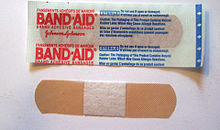Band-Aid
 | |
 | |
| Product type | Adhesive bandage/dressing |
|---|---|
| Owner | Kenvue |
| Country | U.S. |
| Introduced | June 1920 (invention) |
| Markets | Worldwide |
| Tagline | |
| Website | www |

Band-Aid is a brand of adhesive bandages distributed by the consumer health company Kenvue, spun off from Johnson & Johnson in 2023.[3] Invented in 1920, the brand has become a generic term for adhesive bandages in countries such as the United States, Canada, Australia, the Philippines, and others.
History[edit]
The Band-Aid was invented in 1920 by a Johnson & Johnson employee, Earle Dickson, in Highland Park, New Jersey,[4] for his wife Josephine, who frequently cut and burned herself while cooking.[5] The prototype allowed her to dress her wounds without assistance. Dickson passed the idea on to his employer, which went on to produce and market the product as the Band-Aid. Dickson had a successful career at Johnson & Johnson, rising to vice president before his retirement in 1957.
The original Band-Aids were handmade and not very popular. By 1924, Johnson & Johnson introduced machine-made Band-Aids and began the sale of sterilized Band-Aids in 1939.[6]
In World War II, millions were shipped overseas, helping popularize the product. Since then, Johnson & Johnson has estimated a sale of over 100 billion Band-Aids worldwide.[7]
In 1951, the first decorative Band-Aids were introduced. They continue to be a commercial success, with such themes as Mickey Mouse, Donald Duck, Superman, Spider-Man, Rocket Power, Rugrats, smiley faces, Barbie, Dora the Explorer, Elmo, and Batman.
In 2022, Band-Aid was named the most trusted brand in the United States, beating the second place brand, Lysol, by more than two points.[8]
Trademark status[edit]

Band-Aid has, over time, become a well-known example of a genericized trademark in the United States, Canada and South America,[9] but Johnson & Johnson has registered Band-Aid as a trademark on the Principal Register of the United States Patent and Trademark Office, and the registration is valid and legal.[10] Johnson & Johnson continues to defend the Band-Aid trademark against it being genericized.[11]
See also[edit]
- Elastoplast, a comparable European brand and genericized trademark
References[edit]
- ^ "History of Innovation". Band-Aid. Johnson & Johnson. Retrieved 24 November 2022.
- ^ "Band-Aid". Band-Aid. Johnson & Johnson. Retrieved 24 November 2022.
- ^ "Kenvue | A new name for an iconic consumer health company". Lippincott.
- ^ "Historical timeline". hphistory.org. Retrieved 2018-06-02.
- ^ "BAND-AID® Brand Heritage". Johnson & Johnson. April 2015. Archived from the original on June 15, 2013. Retrieved September 21, 2015.
- ^ "The History of the Band-Aid". Retrieved 25 August 2018.
- ^ "The Story of the Black Band-Aid". The Atlantic. 2013-06-06. Retrieved 25 August 2018.
- ^ "Most Trusted Brands 2022". Morning Consult. Retrieved 2022-10-05.
- ^ "Has band-aid become a generic trademark?". genericides.org. Archived from the original on April 29, 2021. Retrieved April 29, 2021.
- ^ "Trademark Status & Document Retrieval: BAND-AID". USPTO. May 15, 2012. Retrieved September 21, 2015.
- ^ Wenlei, Ma (July 1, 2014). "The curse of generification for brands such as Band-Aid, Hoover, Google, Xerox and escalator". News.com.au. Retrieved 12 May 2021.
